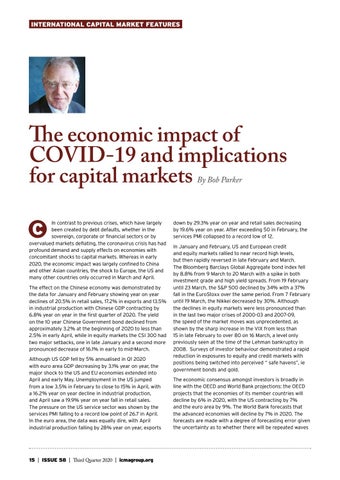SECTION TITLE INTERNATIONAL
CAPITAL MARKET FEATURES
The economic impact of COVID-19 and implications for capital markets By Bob Parker
In contrast to previous crises, which have largely been created by debt defaults, whether in the sovereign, corporate or financial sectors or by overvalued markets deflating, the coronavirus crisis has had profound demand and supply effects on economies with concomitant shocks to capital markets. Whereas in early 2020, the economic impact was largely confined to China and other Asian countries, the shock to Europe, the US and many other countries only occurred in March and April. The effect on the Chinese economy was demonstrated by the data for January and February showing year on year declines of 20.5% in retail sales, 17.2% in exports and 13.5% in industrial production with Chinese GDP contracting by 6.8% year on year in the first quarter of 2020. The yield on the 10 year Chinese Government bond declined from approximately 3.2% at the beginning of 2020 to less than 2.5% in early April, while in equity markets the CSI 300 had two major setbacks, one in late January and a second more pronounced decrease of 16.1% in early to mid-March. Although US GDP fell by 5% annualised in Q1 2020 with euro area GDP decreasing by 3.1% year on year, the major shock to the US and EU economies extended into April and early May. Unemployment in the US jumped from a low 3.5% in February to close to 15% in April, with a 16.2% year on year decline in industrial production, and April saw a 19.9% year on year fall in retail sales. The pressure on the US service sector was shown by the services PMI falling to a record low point of 26.7 in April. In the euro area, the data was equally dire, with April industrial production falling by 28% year on year, exports
15 | ISSUE 58 | Third Quarter 2020 | icmagroup.org
down by 29.3% year on year and retail sales decreasing by 19.6% year on year. After exceeding 50 in February, the services PMI collapsed to a record low of 12. In January and February, US and European credit and equity markets rallied to near record high levels, but then rapidly reversed in late February and March. The Bloomberg Barclays Global Aggregate bond index fell by 8.8% from 9 March to 20 March with a spike in both investment grade and high yield spreads. From 19 February until 23 March, the S&P 500 declined by 34% with a 37% fall in the EuroStoxx over the same period. From 7 February until 19 March, the Nikkei decreased by 30%. Although the declines in equity markets were less pronounced than in the last two major crises of 2000-03 and 2007-09, the speed of the market moves was unprecedented, as shown by the sharp increase in the VIX from less than 15 in late February to over 80 on 16 March, a level only previously seen at the time of the Lehman bankruptcy in 2008. Surveys of investor behaviour demonstrated a rapid reduction in exposures to equity and credit markets with positions being switched into perceived “ safe havens”, ie government bonds and gold. The economic consensus amongst investors is broadly in line with the OECD and World Bank projections: the OECD projects that the economies of its member countries will decline by 6% in 2020, with the US contracting by 7% and the euro area by 9%. The World Bank forecasts that the advanced economies will decline by 7% in 2020. The forecasts are made with a degree of forecasting error given the uncertainty as to whether there will be repeated waves







